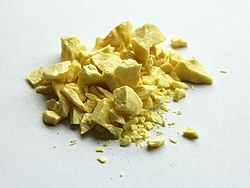Chlorine
The seventeenth element is Chlorine. It has 17 electrons, 2 in the inner shell, 8 in the 2nd and 7 in the third, thus leaving one space in the outer shell to completely fill it. Elements with one space in their outer shells are grouped in the Halogen family. This is the second halogen we have met, Fluorine being the first.
Chlorine is a green coloured gas which was first isolated in the 1770s. The gas is poisonous. It also has a bleaching effect, taking the colour out of things it comes in contact with. The gas is not found in nature as Chlorine is very reactive and combines with other elements to give compounds.
Most people are familiar with the smell of Chlorine - it is used in very small quantities in our drinking water and also in swimming pools to kill bacteria.
One of the compounds, Sodium Chloride, is used regularly in our kitchens - we refer to it as salt. It seems hard to believe that if the gaseous molecules of Chlorine combine with the metal atoms of sodium that a white crystalline solid which we know as salt results.


